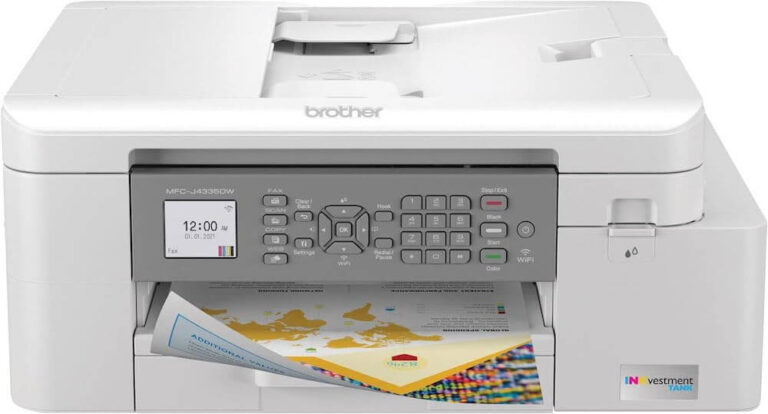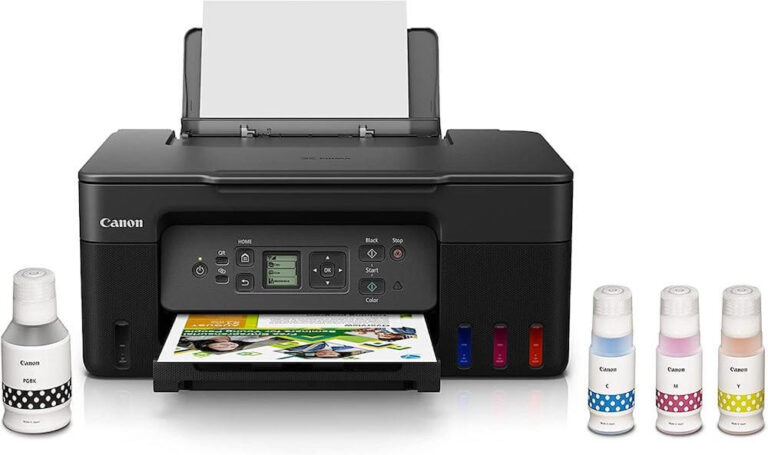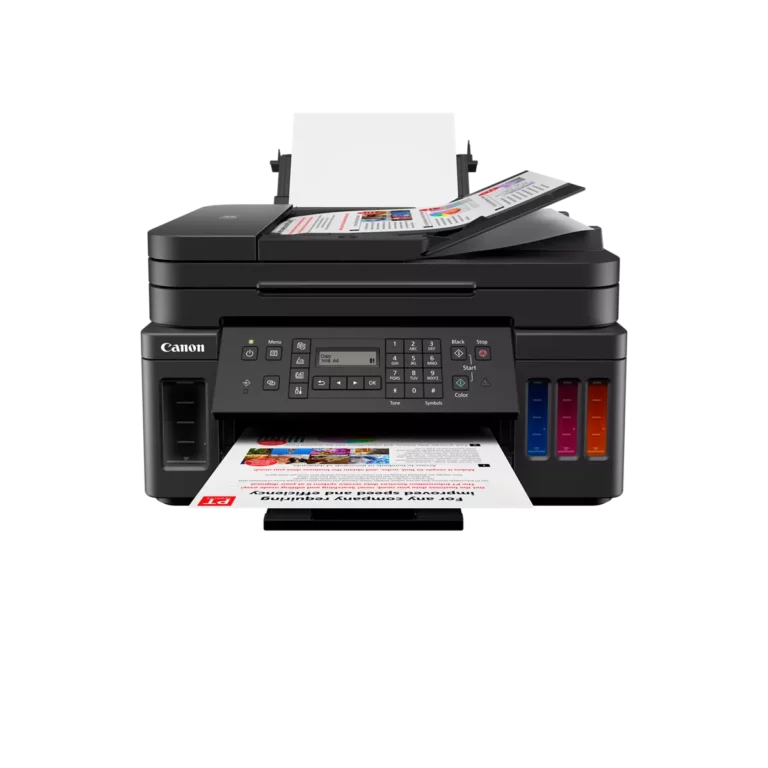If you’re in the market for a new printer, you’re likely facing a crucial dilemma: inkjet or laser?
As a rule, inkjet printers are cheaper than laser printers, but the cost of their upkeep may be a bit higher in the long run. And while they might not be the best choice for businesses, inkjet printers are still the go-to option for personal-use printers.
In this article, we’ll answer all the questions you may have about inkjet printers. We’ll also compare them with laser printers to help you decide which one is better for you.
How Inkjet Printers Work
Inkjet printing is an upgrade of the once-popular dot-matrix printing technology. The old dot-matrix printers had dozens of small needles organized in a rectangular shape. These needles would press against an ink ribbon, thus applying it to the paper. The resulting prints had a characteristic “dotty” look that you can still occasionally see on some official forms and documents.
When inkjet printers first appeared, they utilized a similar mechanism. Instead of needles, they had hundreds of tiny ink guns to eliminate the need for colored ribbons. At the press of the “print” button, the guns start applying the ink to the paper in a very precise way, resulting in far more accurate prints.
A standard inkjet printer has the following components that enable it to work properly:
- A motor-powered main roller that helps move the paper during the printing process
- Several other rollers and wheels that keep the paper firmly in place and prevent it from folding
- An adjustable ribbon that converts the printing instructions into executable information
- An ink cartridge with hundreds of tiny guns that apply the ink to the paper
- A metal rail that enables the printer head to move during the process
Interestingly, inkjet printers print the information in two directions – from left to right first and then from right to left. This is called “bidirectional printing” and its main purpose is to make the whole process faster. So when the printer head finishes printing one line or area of the page from left to right, it proceeds to print the next line from right to left rather than going back to its initial position.
The Most Common Types of Inkjet Printers
Most inkjet printers that are available nowadays utilize the so-called “drop-on-demand” (DOD) technology to create high-quality prints. This means that the printer only applies the ink guns – or “drops” ink – to the paper when needed. Otherwise, it remains idle, waiting for further instructions.
This is the opposite of “continuous inkjet” (CIJ), where the guns are always charged and working. CIJ technology is most often seen in commercial printing. When it comes to consumer printers, they tend to use one of the two common types of DOD technology.
Thermal DOD Printers
Manufacturers like Canon and Hewlett-Packard focus on thermal DOD inkjet printers. Like their name suggests, these printers use heat to power up the ink guns or nozzles. To achieve that, the mechanism inside the case sends an electric current down to a small resistor located near the guns.
The electricity then raises the temperature, prompting the ink in the guns to start boiling. In a matter of seconds, the boiling ink starts vaporizing, thus forming small vapor bubbles. As the temperature grows even higher, these tiny bubbles then burst onto the paper following the predefined printing pattern.
Piezoelectric DOD Printers
Epson and Brothers are the two top manufacturers of piezoelectric DOD inkjet printers. Like the thermal DOD printers, they also use electricity to power up the ink guns. Yet unlike them, they apply pressure to the ink container instead of heat.
These printers have a piezoelectric crystal with two small electric contact spots. When you press the “print” button, the printer will apply pressure to the crystal via these contact spots, causing it to expand. This, in turn, will apply pressure to the ink nozzle, which will then force one drop of ink out toward the paper.
The Pros and Cons of Inkjet Printers
As with all other consumer products, inkjet printers also have their advantages and shortcomings. Your decision to get an inkjet printer will likely depend on your printing needs, i.e. how often you’ll use the printer and for what type of projects.
Here are the main pros and cons of inkjet printers that you should also consider.
Pros
- Inkjet printers are considerably cheaper than laser printers. What’s more, even the cost of ink cartridges is lower than the cost of new toner cartridges. As such, inkjet printers may turn out to be a better investment in the long run.
- If the ink in the cartridge runs out, they are very easy to replace. Moreover, you don’t have to buy a new cartridge, as there are many services that offer ink refills. You can thus reuse the same cartridge for an indefinite number of times, thus saving a lot of money in the process.
- Most modern inkjet printers don’t require any warm-up time before they become functional. This is particularly convenient if you need to print something out very quickly.
- As their name suggests, inkjet printers are great for printing demanding, color-heavy projects, like photographs and images. They are also good at meshing solid colors together, resulting in a highly accurate print.
- They can print on any type of paper regardless of its structure and weight. Inkjet printers work well with bank paper, bond paper, as well as glossy paper. What’s more, you can even use them to print text and images on some softer fabrics.
- Not only do they save money but inkjet printers also save space. As a rule, they are generally smaller than laser printers. On top of that, it’s much easier to replace and recycle a small ink cartridge than a large toner cartridge.
Cons
- The printing ink contains water, which means that it can easily run before it dries. While it’s still wet, it may also smudge due to improper handling of the paper. Finally, if you don’t store it the right way, the print could even fade over time.
- Despite the use of bidirectional printing, inkjet printers are still slower than laser printers. That’s because laser models print out the entire page at once. Unlike them, inkjet models can only print out one section of the page at a time.
- Most standard inkjet printers only carry enough ink for no more than a few hundred pages. After that, you’ll need to replace or refill your empty tanks. This can be very inconvenient if you need to do a lot of printing on a regular basis.
Inkjet vs. Laser
Laser printers are usually considerably faster than inkjet printers. They can also take on a much larger workload before the toner cartridge needs replacing. And even though they are more expensive than inkjet printers, they might still be more cost-effective if you plan to do large amounts of printing.
But there are some areas where laser printers are somewhat inferior. For one, when you power up the unit, you need to wait until it warms up to start printing. Furthermore, they are not very versatile as they can only handle regular paper. Finally, they take up a lot more space than inkjet printers and require regular maintenance due to toner spills.
Conclusion
Depending on your printing needs, both a laser and an inkjet printer can be a good choice. If you need a printer that can handle a heavy workload, you might prefer getting a laser printer.
But if you need a printer for personal use, then an inkjet printer could be the better solution. It can handle all small printing projects regardless of how complex they are. It also works with all types of paper and even some fabrics. On top of that, it costs less, requires less maintenance, and takes up less space.


